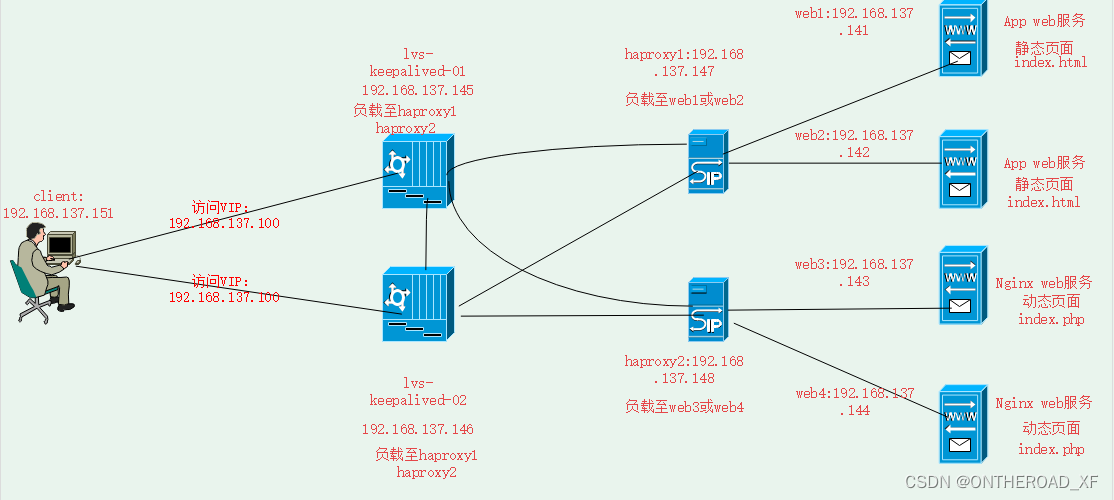以下步骤为个人实验环境
简单原理:客户端访问对外入口lvs+keepalived(四层),lvs将请求负载至后端两台haproxy(七层),haproxy再将请求负载至后端服务器。
如下拓扑图:

一、准备工作
1、9台虚拟机
| 主机 | IP | 作用 |
|---|---|---|
| 192.168.137.100 | 虚拟IP | |
| lvs-keepalived-01 | 192.168.137.145 | LVS将请求负载至haproxy中的一台 |
| lvs-keepalived-02 | 192.168.137.146 | LVS-KEEPALIVED的备份 |
| haproxy | 192.168.137.147 | haproxy-01 将请求负载至后端web |
| haproxy | 192.168.137.148 | haproxy-02 将请求负载至后端web |
| web1 | 192.168.137.141 | web1静态服务器 |
| web2 | 192.168.137.142 | web2静态服务器 |
| web3 | 192.168.137.143 | web3动态服务器 |
| web4 | 192.168.137.144 | web4动态服务器 |
| client | 192.168.137.151 | 客户端虚拟机用于测试 |
配置域名/etc/hosts
二、安装软件及配置
1、在两台lvs-keepalived上安装 ipvsadm和keepalived
yum install -y ipvsadm keepalived
2、在两台haproxy虚拟机上安装haproxy
yum install -y haproxy
3、web3、web4安装Nginx PHP
yum install -y epel-release
yum install -y nginx php-fpm
4、配置网页
web1、web2在/var/www/html/下各自创建index.html,测试内容自定。
web3、web4在/usr/share/nginx/html/下各自创建index.php,添加如下内容
<?
phpinfo()
php?>
配置nginx,添加php模块
# For more information on configuration, see:
# * Official English Documentation: http://nginx.org/en/docs/
# * Official Russian Documentation: http://nginx.org/ru/docs/
user nginx;
worker_processes auto;
error_log /var/log/nginx/error.log;
pid /run/nginx.pid;
# Load dynamic modules. See /usr/share/doc/nginx/README.dynamic.
include /usr/share/nginx/modules/*.conf;
events {
worker_connections 1024;
}
http {
log_format main '$remote_addr - $remote_user [$time_local] "$request" '
'$status $body_bytes_sent "$http_referer" '
'"$http_user_agent" "$http_x_forwarded_for"';
access_log /var/log/nginx/access.log main;
sendfile on;
tcp_nopush on;
tcp_nodelay on;
keepalive_timeout 65;
types_hash_max_size 4096;
include /etc/nginx/mime.types;
default_type application/octet-stream;
# Load modular configuration files from the /etc/nginx/conf.d directory.
# See http://nginx.org/en/docs/ngx_core_module.html#include
# for more information.
include /etc/nginx/conf.d/*.conf;
server {
listen 80;
listen [::]:80;
server_name _;
root /usr/share/nginx/html;
# Load configuration files for the default server block.
include /etc/nginx/default.d/*.conf;
location / {
index index.php index.html;
}
error_page 404 /404.html;
location = /404.html {
}
error_page 500 502 503 504 /50x.html;
location = /50x.html {
}
location ~ \.php$ {
root /usr/share/nginx/html;
fastcgi_pass 127.0.0.1:9000;
fastcgi_index index.php;
fastcgi_param SCRIPT_FILENAME $document_root$fastcgi_script_name;
include fastcgi_params;
}
}
# Settings for a TLS enabled server.
#
# server {
# listen 443 ssl http2;
# listen [::]:443 ssl http2;
# server_name _;
# root /usr/share/nginx/html;
#
# ssl_certificate "/etc/pki/nginx/server.crt";
# ssl_certificate_key "/etc/pki/nginx/private/server.key";
# ssl_session_cache shared:SSL:1m;
# ssl_session_timeout 10m;
# ssl_ciphers HIGH:!aNULL:!MD5;
# ssl_prefer_server_ciphers on;
#
# # Load configuration files for the default server block.
# include /etc/nginx/default.d/*.conf;
#
# error_page 404 /404.html;
# location = /40x.html {
# }
#
# error_page 500 502 503 504 /50x.html;
# location = /50x.html {
# }
# }
}
5、配置keepalived
vim /etc/keepalived/keepalived.conf
# Global Configuration
global_defs {
lvs_id director1 # 指定lvs的id
}
# VRRP Configuration
vrrp_instance LVS {
state MASTER # 指定当前节点为master节点
interface ens33 # 这里是网卡的名称,通过ifconfig或者ip addr可以查看
virtual_router_id 51 # 这里指定的是虚拟路由id,master节点和backup节点需要指定一样的
priority 150 # 指定了当前节点的优先级,数值越大优先级越高,master节点要高于backup节点
advert_int 1 # 指定发送VRRP通告的间隔,单位是秒
authentication {
auth_type PASS # 鉴权,默认通过
auth_pass 1111 # 鉴权访问密码
}
virtual_ipaddress {
192.168.137.100 # 指定了虚拟ip
}
}
# Virtual Server Configuration - for www server
# 后台真实主机的配置
virtual_server 192.168.137.100 80 {
delay_loop 1 # 健康检查的时间间隔
lb_algo rr # 负载均衡策略,这里是轮询
lb_kind DR # 调度器类型,这里是DR
persistence_time 1 # 指定了持续将请求打到同一台真实主机的时间长度
protocol TCP # 指定了访问后台真实主机的协议类型
# Real Server 1 configuration
# 指定了真实主机1的ip和端口 , 也就是haproxy-01的IP和端口
real_server 192.168.137.145 80 {
weight 1 # 指定了当前主机的权重
TCP_CHECK {
connection_timeout 10 # 指定了进行心跳检查的超时时间
}
}
# Real Server 2 Configuration
# 指定了真实主机2的ip和端口 , 也就是haproxy-02的IP和端口
real_server 192.168.137.146 80 {
weight 1 # 指定了当前主机的权重
TCP_CHECK {
connection_timeout 10 # 指定了进行心跳检查的超时时间
}
}
}
在lvs-keepalived-02也就是backup 机器上面配置keepalived:
只和master 有以下三处不同:
lvs_id director1 改成 lvs_id director2
state MASTER 改成 state BACKUP
priority 150 改成 priority 100
6、配置haproxy
两台虚拟机配置相同,将访问本机80端口的请求负载至后端web服务器,实现动静分离。
vim /etc/haproxy/haproxy.cfg
global
log 127.0.0.1 local3 info
maxconn 4096
user nobody
group nobody
daemon
nbproc 1
pidfile /run/haproxy.pid
defaults
log global
mode http
maxconn 2048
retries 3
option redispatch
timeout connect 5000
timeout client 50000
timeout server 50000
option abortonclose
stats uri /admin?stats
stats realm Private lands
stats auth admin:password
stats hide-version
frontend http-in
bind 0.0.0.0:80
mode http
log global
option httplog
option httpclose
#定义请求html的规则
acl html url_reg -i \.html$
#定义请求php的规则
acl php url_reg -i \.php$
#当请求的资源为html时走htnl-server
use_backend html-server if html
#当请求的资源为php时走htnl-php
use_backend php-server if php
#默认使用
default_backend html-server
#静态服务器
backend html-server
mode http
balance roundrobin
option httpchk GET /index.html
cookie SERVERID insert indirect nocache
server html-A web1:80 weight 1 cookie 3 check inter 2000 rise 2 fall 5
server html-B web2:80 weight 1 cookie 3 check inter 2000 rise 2 fall 5
#动态服务器
backend php-server
mode http
balance roundrobin
option httpchk GET /index.php
cookie SERVERID insert indirect nocache
server html-A web3:80 weight 1 cookie 3 check inter 2000 rise 2 fall 5
server html-B web4:80 weight 1 cookie 3 check inter 2000 rise 2 fall 5
在两台haproxy虚拟机本地回环接口上配置虚拟IP,使用脚本配置
cd /etc/init.d/
vim lvsrs
SNS_VIP=192.168.137.100
/etc/rc.d/init.d/functions
case "$1" in
start)
ifconfig lo:0 $SNS_VIP netmask 255.255.255.255 broadcast $SNS_VIP
/sbin/route add -host $SNS_VIP dev lo:0
echo "1" >/proc/sys/net/ipv4/conf/lo/arp_ignore
echo "2" >/proc/sys/net/ipv4/conf/lo/arp_announce
echo "1" >/proc/sys/net/ipv4/conf/all/arp_ignore
echo "2" >/proc/sys/net/ipv4/conf/all/arp_announce
sysctl -p >/dev/null 2>&1
echo "RealServer Start OK"
;;
stop)
ifconfig lo:0 down
route del $SNS_VIP >/dev/null 2>&1
echo "0" >/proc/sys/net/ipv4/conf/lo/arp_ignore
echo "0" >/proc/sys/net/ipv4/conf/lo/arp_announce
echo "0" >/proc/sys/net/ipv4/conf/all/arp_ignore
echo "0" >/proc/sys/net/ipv4/conf/all/arp_announce
echo "RealServer Stoped"
;;
*)
echo "Usage: $0 {start|stop}"
exit 1
esac
exit 0
更改脚本权限并执行
chmod 755 lvsrs
./lvsrs start
通过ip a,和route查看是否添加虚拟ip和路由成功
7、cient安装elinks
yum install -y elinks
8、测试
检查防火墙和selinux并关闭,启动keepalived、nginx、haproxy
使用elinks访问vip
elinks --dump http://192.168.137.100/
elinks --dump http://192.168.137.100/index.php
通过验证,我们的集群搭建完成,后续可以结合ansible,zabbix、elk等技术。
参考:https://blog.csdn.net/qq_28187347/article/details/106748056






















 329
329











 被折叠的 条评论
为什么被折叠?
被折叠的 条评论
为什么被折叠?










